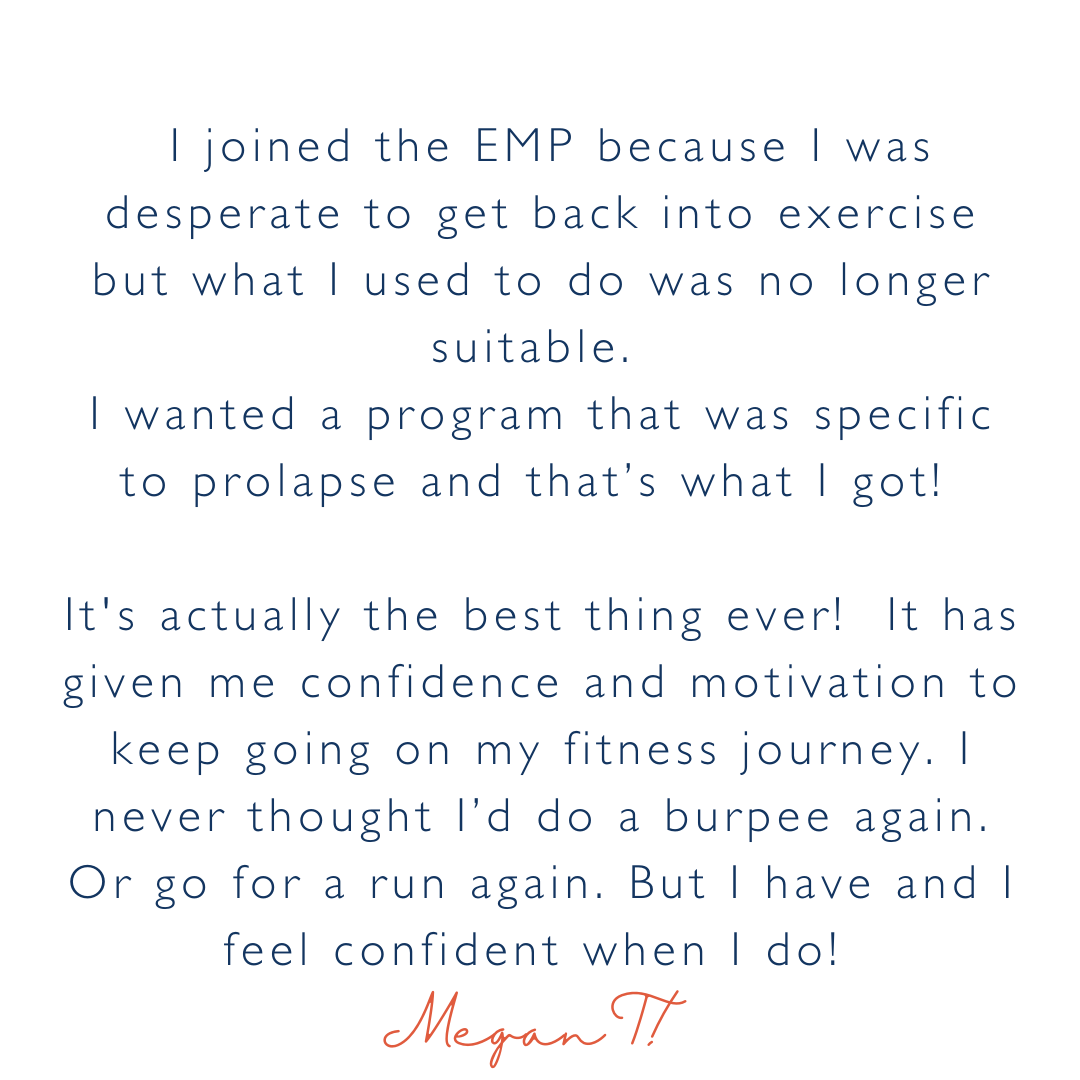POP Awareness Month - What Exercise is Safe with Prolapse?
Prolapse is much more than 'just' a physical condition. It affects every area of your wellbeing - mental, emotional, sexual and social.
Right now you may feel like your body has failed you. You might feel a little broken or that your old life has suddenly been whipped out from under you.
We are here to remind you that you aren't broken. Your body hasn't failed you. And you definitely didn't cause your prolapse. With the right treatment and support, you can live a healthy, active life with prolapse.
In the Empowered Motherhood Program, we are passionate about showing you just what you can do with prolapse. Which is a lot! We actually have a 12 month program dedicated to helping you to heal your prolapse and return to the type of exercise you love!
We believe that with the right movement patterns and technique, almost all forms of exercise can be done safely with prolapse.
In this video, Women’s Health Physiotherapist and Founder of the Empowered Motherhood Program Lyz Evans shows you the EMP method of feeling strong with prolapse.
You can watch this video now or read on!

What is Pelvic Organ Prolapse?
A pelvic organ prolapse or POP is the descent of one or more of the pelvic organs into the vaginal canal.
Your pelvic organs are supported by the levator ani (LA) muscles and the connective tissues that attach the uterus and vagina to the pelvic sidewalls. The LA muscles provide lift and closure against downward forces. Which is why there is a lot of focus on pelvic floor strengthening to support prolapse.
With each pregnancy and vaginal birth, the levator ani muscles stretch and thin out and the levator hiatus (the opening through which the urethra, vagina and bowel pass) becomes wider. As the size of the hiatus increases, there is less support for the pelvic organs and more opportunity for them to descend into the vaginal canal.
This can lead to feelings of heaviness or like you are wearing a thick pad or have a golf ball stuck in your vagina.
None of these feelings are pleasant, and over the longer term, they can deeply affect the way you feel about your body and yourself.

Why Does Prolapse Happen?
Prolapse can happen for a variety of reasons. Pregnancy, childbirth, history of chronic constipation, genetics, biomechanics, hormones, weight and a history of high impact movement can all contribute.
However, pelvic organ prolapse isn't purely a result of weak pelvic floor muscles. A prolapse is often caused by poor biomechanics and movement patterns, an inability to manage and distribute pressure throughout the core cannister and increased tension or tightness in other areas of the body.
It is really important for you healing to understand that nothing you did caused your prolapse. No one act or choice on your part led to this condition. And just like no one factor caused your prolapse, no one factor will help you to heal it.
From now on, we want you to focus on a range of methods to help your pelvic floor function optimally and your pelvic organs feel more supported.
We cover all of these in the Empowered Motherhood Program and incorporate them into all of our workouts so that every time you move - you are healing your body.
- Proper Breathing.
- Optimal Posture.
- Movement Patterns.
- Mental and Emotional Support.
- Core and Pelvic Floor Strength.
- Pressure Regulation.
- Creating full-body strength.
- Returning to impact safely.
If it is an option for you, working with a Women's Health Physio for manual treatment, pelvic floor support, biomechanics and fascial release is also incredibly important if you are living with prolapse.

Pelvic Organ Prolapse Stages
- Stage 1: Very mild prolapse – organs are still fairly well supported by the pelvic floor.
- Stage 2: Pelvic floor organs have begun to descend, but are still contained inside the vagina.
- Stage 3: Pelvic floor organs have fallen to or beyond the opening of the vagina.
- Stage 4: Pelvic floor organs have fallen completely through the vaginal opening.

How do you know if you have a prolapse?
Some women with POP may experience no symptoms at all. For the remaining percentage of women who do experience symptoms, a prolapse might feel like a heaviness or dragging in the vagina.
You may be able to see the organs at the vaginal entrance or protruding out of the vagina. There may also be a range of accompanying conditions such as urinary incontinence, trouble having bowel motions, trouble keeping a tampon in or pain or lack of sensation during sex.
If you are concerned at all or have any of these symptoms, please make an appointment with your GP or Women's Health Physio.
Living with prolapse may feel disempowering, uncomfortable. You may even experience feelings of despair. There is a lot of information on what you can’t do with prolapse.
We want to show you what you can do (which is a lot!).

Want a Free 5 Day Trial of the Empowered Motherhood Program?
Physio-Led Exercise + Expert Education for a Strong Pregnancy and Informed Birth
- Want safe workouts for every single stage of your pregnancy.
- Want advice from experts you can trust and women who have been through pregnancy before.
- Want workouts for pelvic, back and pubic pain in case you ever need them
You're in the right place!
Our Empowered Motherhood Postnatal Program is the most in-depth program ever created. Expert-led, we have programs for the issues that are ignored by other programs.
Test us out with a Free 5 Day Trial on all our memberships!

Start your Empowered Motherhood with 3 Free Workouts
Download three free videos for either pregnancy or postpartum. Led by Women's Health Physio Lyz Evans + PT Kimmy Smith.



